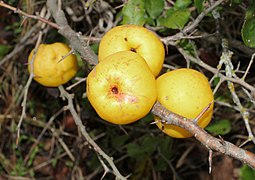Chaenomeles japonica
| Chaenomeles japonica | |
|---|---|

| |
| Scientific classification | |
| Kingdom: | Plantae |
| Clade: | Tracheophytes |
| Clade: | Angiosperms |
| Clade: | Eudicots |
| Clade: | Rosids |
| Order: | Rosales |
| Family: | Rosaceae |
| Genus: | Chaenomeles |
| Species: | C. japonica
|
| Binomial name | |
| Chaenomeles japonica | |
| Synonyms[1] | |
|
List
| |
Chaenomeles japonica, called the Japanese quince or Maule's quince,[2] is a species of flowering quince that is native to Japan.
It is a thorny deciduous shrub that is commonly cultivated. It is shorter than another commonly cultivated species C. speciosa, growing to only about 1 m in height. It is best known for its colorful spring flowers, which are red, white, pink or multicoloured.
Description
It is a bulky shrub with
It blooms in winter, before leaf budding; it blooms again in summer but with less abundance. Usually there are 2 to 3 flowers arranged together; they are coloured orange to brick red. When open, the flowers are 3 to 4 centimeters wide. The fruit is called Kusa-boke (草木瓜, Kusa-boke) in Japanese. It produces apple-shaped fruit, 4 to 7 centimeters in diameter, that are a golden-yellow color containing red-brown seeds.[5]
Uses
The fruit is edible, but hard and
Gallery
-
Flowers
-
Fruit
-
Whole plant
References
- ^ "Chaenomeles japonica (Thunb.) Lindl. ex Spach". Plants of the World Online. Board of Trustees of the Royal Botanic Gardens, Kew. 2017. Retrieved 12 December 2020.
- ISBN 978-89-97450-98-5. Archived from the original (PDF) on 25 May 2017. Retrieved 4 January 2017 – via Korea Forest Service.
- ^ Herfried Kutzelnigg: Maloideae . In: Hans. J. Conert et al. (Ed.): Gustav Hegi. Illustrated flora of Central Europe. Volume 4 Part 2B: Spermatophyta: Angiospermae: Dicotyledones 2 (3). Rosaceae 2 . Blackwell 1995. ISBN 3-8263-2533-8
- ^ Bailey, L.H.; Bailey, E.Z.; the staff of the Liberty Hyde Bailey Hortorium. 1976. Hortus third: A concise dictionary of plants cultivated in the United States and Canada. Macmillan, New York.
- ^ Erich Oberdorfer: Plant-sociological excursion flora for Germany and neighboring areas . 8th edition. Verlag Eugen Ulmer, Stuttgart 2001, ISBN 3-8001-3131-5 . Page 501.
- ^ D'Cruz, Mark. "Ma-Ke Bonsai Care Guide for Chaenomeles japonica". Ma-Ke Bonsai. Retrieved 2021-02-04.



